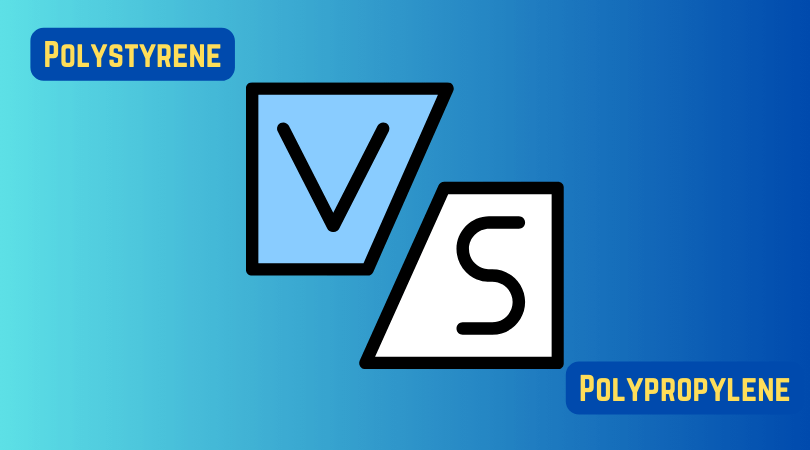The two predominant polymers utilized in plastic manufacturing are polypropylene and polystyrene. Polymers are essentially vast molecules composed of repeating structural units called monomers.
One would observe similarities and noteworthy differences in a side-by-side comparison of polypropylene and polystyrene.
These distinguishing features render each more appropriate for particular applications.

Polystyrene VS Polypropylene
The aim is to offer readers a detailed look into what makes polystyrene and polypropylene similar yet different, so they can make well-informed decisions when choosing between these materials.
What is Polystyrene
Polystyrene (PS) is a prevalent plastic synthesized through styrene, an aromatic hydrocarbon polymerization.
It is commonly used in its expanded or foamed state, achieved through hydrocarbons or HCFC gas dissolution.
These gases can be rapidly removed by reducing applied pressure, resulting in the foam structure.
Polystyrene structure is optically clear in its unexpanded form but can quickly adopt opaque and translucent hues. It is a rigid, brittle material with limited oxygen and water vapor resistance.
PS remains a clear solid at room temperature but transitions into a liquid state at 240°C, a characteristic thermoplastic behavior conducive to manufacturing via injection molding and extrusion.
PS has an extensive historical background, first serendipitously discovered in 1839 by Eduard Simon, a Berlin-based apothecary.
His initial observations on styrol thickening into a gel were later recognized as macromolecule formation, not oxygenation as he initially thought.
Industrial-scale production of PS was first accomplished by IG Farben in 1931, followed by the patenting of expanded PS by Dow Chemicals in 1949.
Much like Polypropylene (PP) (, which I will discuss shortly), PS is an addition polymer and can exist in three fundamental forms:
Atactic PS (PS-at): This form is amorphous due to the random orientation of its monomer groups and is the most commonly produced variant.
Syndiotactic PS (PS-st): This form has an alternating monomer orientation achieved through Ziegler-Natta polymerization.
It is relatively rare and is blended with nylon to create lightweight, high-temperature-stable materials primarily used in automotive and electrical components.
Isotactic PS (PS-it): The monomer groups are aligned in the same direction in this form. However, it is not commercially produced.
What is Polypropylene
Polypropylene, commonly known as PP, is a type of “addition polymer” made in several different forms, each with properties like strength, density, chemical resistance, and how it responds to heat. Here are the various types:
Isotactic Polypropylene (iPP or PPi): This is the most common type in stores. It has a high melting point, over 160°C, and is used in many products.
Polypropylene Fibers: These are used often in things like fabric, ropes, etc. When these fibers are made, the tiny chains of the polymer line up in a specific way, giving them unique characteristics that are highly valued.
Atactic Polypropylene (aPP or PPa): This form doesn’t have a regular structure, which means it’s not valid for making products. It’s very soft and can easily tear or crumble.
Block Copolymer Polypropylene: This type is still in the experimental stage. It’s not sold yet but has exciting features. It’s made of different atactic and isotactic sections, combining soft and hard regions.
Syndiotactic Polypropylene (sPP or PPs): In this type, the tiny building blocks of the polymer alternate in a regular pattern. This gives it improved electrical properties compared to other forms.
Biaxially-Oriented Polypropylene (BOPP): This type has been stretched in two different directions, making it very transparent and giving it better strength and resistance to chemicals and heat.
Although these types are made of the same essential ingredients, how they are arranged can significantly change their properties.
Some forms can be modified to create even more classes with different features.
Paul Hogan and Robert Banks made the first polypropylene version at Phillips Petroleum in 1951. Later, scientists named Natta and Rehn in Spain improved it in 1954. By 1957, this material was widely used in Europe and the United States.
One intriguing feature of polypropylene is its tacticity, which refers to the spatial arrangement of its methyl groups.
Polypropylene structure plays a critical role in determining its mechanical properties.
For example, in isotactic polypropylene, the uniform arrangement of methyl groups contributes to its exceptional strength and long-lasting nature.
This form is prevalently employed in various applications, such as fibers and molded components particularly pipes.
Moreover, polypropylene’s unique combination of lightness and strength makes it particularly valuable in the healthcare industry.
It’s used in various car and truck parts, from dashboards to door panels, and has substantially contributed to reducing vehicle weight, thereby enhancing fuel efficiency.
Polypropylene VS Polystyrene: Applications and Uses
Polypropylene and polystyrene are sometimes interchangeable, especially in stricter variants like HIPS and ABS. Consequently, both materials find usage in various similar applications across sectors.
Here’s a rundown of key industries and how they utilize Polypropylene:
Furniture: Incorporated in resin-based outdoor and household furniture and ornamental and low-stress surface panels in more upscale furnishings.
Packaging Sector: Utilized for bottles for liquids (excluding the caps), containers for food, transparent films, and films that can shrink with heat.
Automotive Industry: Employed in systems for air management in engines and air conditioning, interior elements, liners for mud, insulation for electrical systems, and trays for lead-acid batteries.
Textiles and Floor Coverings: Used in inherently colored and durable fibers for textiles, carpets, woven coverings like tarpaulins, synthetic grass like astroturf, and non-woven fabrics for protective clothing.
Healthcare: Used in manufacturing barrels for syringes, containers for medication, various tubing, and face masks.
Consumer Goods: Common household items for storage and managing liquids, such as water tanks, buckets, and septic systems. Also used in the bodies and handles of electrical appliances, toothbrushes, baby gear, utensils, liners for pools and ponds, gardening tools, and luggage.
Chemical Sector: Features in pipelines and components for valves that aren’t under stress, mainly when dealing with harsh chemical reactions.
These are the primary sectors and applications where polypropylene is actively used, showcasing its versatility across industries.
Primary Industries and Applications Utilizing Polystyrene (Extruded/Calendered Sheets and Molded Items)
Packaging Sector: Expanded polystyrene is frequently used in packaging applications such as hinged food containers, cut-block spacers, and as cushioning material inside boxes. High Impact Polystyrene (HIPS) is another option for constructing thicker-walled containers and bottles, with yogurt pots as a prevalent example.
Automotive Industry: The rigid forms of polystyrene, especially in high-impact and ABS variants, are commonly found in car interior fixtures and fender panel
Food Packaging: When stretched significantly, Oriented HIPS offers decent clarity, making it an excellent choice for transparent food package lids.
Home Appliances: High Impact Polystyrene (HIPS) is extensively used for the inner lining of refrigerators and freezers, components of washing machines and dishwashers, covers for kitchen gadgets, and even toilet seats.
Flotation Applications: Expanded polystyrene is a popular material used for buoyancy aids in boats, ships, and aquatic toys.
Advertising Sector: High Impact Polystyrene is employed structurally in advertising displays and vibrant branding installations.
Comparative Table of Physical Properties: Polypropylene vs Polystyrene
| Physical Property | Polypropylene | Polystyrene |
| Optical Transmission | High in specialized copolymers |
Generally high with occasional cloudiness
|
| Elongation at Break | 2.4–900% | 1–35% |
| Modulus of Elasticity | 0.08–8.25 GPa | 2.59–4.71 GPa |
| Flexural Yield Strength | 0.296–180 MPa | 7.35–106 MPa |
| Hardness (Rockwell R) | 20–118 | 121 |
| Ultimate Tensile Strength | 9–80 MPa | 35–59 MPa |
| Yield Tensile Strength | 4–1350 MPa | 34–55 MPa |
| Flexural Modulus | 0.026–10 GPa | 1.58–3.45 GPa |
| Coefficient of Friction | 0.25 | 0.33 |
| Coefficient of Thermal Expansion | 18.0–185 µm/m-°C | 71–80 µm/m-°C |
| Melting Point | 61–221 °C | 240 °C |
| Max Service Temperature | 65–125 °C | 75–122 °C |
This table outlines the extensive variability in physical properties between polypropylene and polystyrene, two commonly substituted polymers in multiple industries.
It’s important to note that polypropylene shows more comprehensive ranges in many metrics, such as tensile strength and elongation at break, highlighting its versatile applications.
However, polystyrene stands out in particular areas like hardness and optical transmission. Such a comparative view enables better material selection tailored to specific needs, whether one requires a high melting point, elasticity, or strength.
Furthermore, thermal expansion and friction coefficients are crucial for industries with temperature-sensitive applications or those requiring low-friction materials.
By understanding these nuances, one can make more informed decisions in the selection process, optimally balancing performance, durability, and cost-effectiveness.
Polystyrene VS Polypropylene: Cost

When comparing the costs of polypropylene (PP) and polystyrene (PS), several factors come into play, from raw material prices to manufacturing overheads and end-use applications.
Generally, polypropylene tends to be more expensive than polystyrene, especially when specialized copolymers or additives are involved.
The raw material cost for producing polypropylene is often higher due to the complexities of its polymerization process and the catalysts required.
In contrast, polystyrene is relatively more straightforward and less costly to produce, especially in its primary forms.
However, the cost also correlates with the performance features of each material.
Polypropylene offers a broader range of properties, from higher tensile strength to better chemical resistance, which often justifies its higher price tag.
The extra cost can be worthwhile for applications requiring enhanced characteristics—such as automotive parts or medical devices.
On the other hand, if the application only requires basic material properties like rigidity or clarity—such as packaging or disposable cutlery—polystyrene often emerges as the more cost-effective choice.
Furthermore, economies of scale can influence the cost dynamics.
Large-scale polypropylene production can offset some of the high raw material and processing costs, making it more competitive in bulk applications.
Conversely, polystyrene’s relatively more straightforward production process can scale less dramatically in cost reduction.
Summary
Ultimately, the choice between Polystyrene VS Polypropylene isn’t just about dollars and cents; it’s about aligning the material’s properties with your needs. Polypropylene offers a versatile range, from toughness to chemical resistance, making it suitable for long-lasting applications like automotive parts or medical equipment.
Conversely, polystyrene is usually the go-to for single-use items or packaging, offering cost-efficiency and sufficient mechanical properties. So when deciding between the two, consider it a balancing act—weighing factors like durability, strength, and environmental impact against your budget constraints. The ‘right’ material depends on the unique requirements of your project.
Thats it. Thanks for reading.
Quick Navigation
